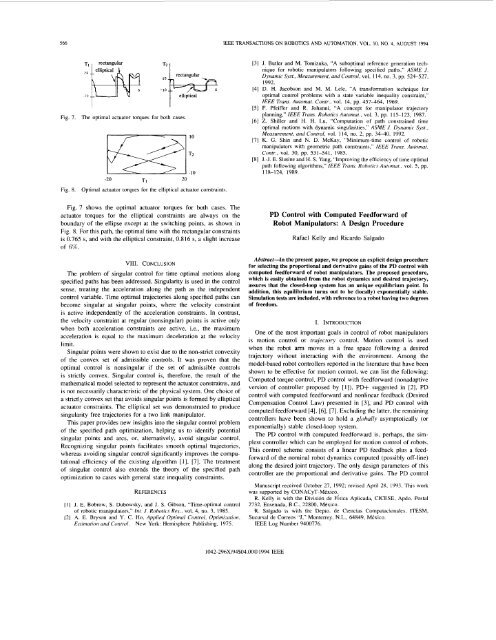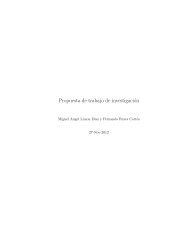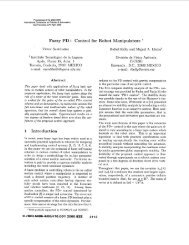2001 Santibañez - PD control with feedforward compensation for robot manipulators analysis and experimentation.pdf
2001 Santibañez - PD control with feedforward compensation for robot manipulators analysis and experimentation.pdf
2001 Santibañez - PD control with feedforward compensation for robot manipulators analysis and experimentation.pdf
Create successful ePaper yourself
Turn your PDF publications into a flip-book with our unique Google optimized e-Paper software.
5 66 IEEE TRANSACTIONS ON ROBOTICS AND AUTOMATION, VOL. IO. NO. 4, AUGUST 1994<br />
rectangular<br />
elliptical<br />
Fig. 7. The optimal actuator torques <strong>for</strong> both cases.<br />
10<br />
T2<br />
-10<br />
[31 J. Butler <strong>and</strong> M. Tomizuka, “A suboptimal reference generation teehnique<br />
<strong>for</strong> <strong>robot</strong>ic <strong>manipulators</strong> following specified paths,” ASME J.<br />
Dynamic Syst., Measurement, <strong>and</strong> Control. vol. 114. no. 3, pp. 524527,<br />
1992.<br />
[4] D. H. Jacobson <strong>and</strong> M. M. Lele, “A trans<strong>for</strong>mation technique <strong>for</strong><br />
optimal <strong>control</strong> problems <strong>with</strong> a state variable inequality constraint,”<br />
IEEE Trans. Automat. Contr.. vol. 14, pp. 457464, 1969.<br />
[5] F. Pfeiffer <strong>and</strong> R. Johanni, “A concept <strong>for</strong> manipulator trajectory<br />
planning,” IEEE Trans. Rohotics Automat., vol. 3, pp. 115-123, 1987.<br />
161 Z. Shiller <strong>and</strong> H. H. Lu, ‘Computation of path constrained time<br />
optimal motions <strong>with</strong> dynamic singularities,” ASME J. Dyntrmic Syst..<br />
Measurement, <strong>and</strong> Control, vol. 114, no. 2, pp. 3440, 1992.<br />
[7] K. G. Shin <strong>and</strong> N. D. McKay, “Minimum-time <strong>control</strong> of <strong>robot</strong>ic<br />
<strong>manipulators</strong> <strong>with</strong> geometric path constraints,” lEEE Truns. Automat.<br />
Contr., vol. 30, pp. 531-541, 1985.<br />
[8] J.-J. E. Slotine <strong>and</strong> H. S. Yang, “Improving the efficiency of time optimal<br />
path following algorithms,” IEEE Trans. Robotic,.\ Automat.. vol. 5, pp.<br />
118-124, 1989.<br />
Fig. 8. Optimal actuator torques <strong>for</strong> the elliptical actuator constraints<br />
Fig. 7 shows the optimal actuator torques <strong>for</strong> both cases. The<br />
actuator torques <strong>for</strong> the elliptical constraints are always on the<br />
boundary of the ellipse except at the switching points, as shown in<br />
Fig. 8. For this path, the optimal time <strong>with</strong> the rectangular constraints<br />
is 0.765 s, <strong>and</strong> <strong>with</strong> the elliptical constraint, 0.816 s, a slight increase<br />
of 6‘,%.<br />
VIII. CONCLUSION<br />
The problem of singular <strong>control</strong> <strong>for</strong> time optimal motions along<br />
specified paths has been addressed. Singularity is used in the <strong>control</strong><br />
sense, treating the acceleration along the path as the independent<br />
<strong>control</strong> variable. Time optimal trajectories along specified paths can<br />
become singular at singular points, where the velocity constraint<br />
is active independently of the acceleration constraints. In contrast,<br />
the velocity constraint at regular (nonsingular) points is active only<br />
when both acceleration constraints are active, i.e., the maximum<br />
acceleration is equal to the maximum deceleration at the velocity<br />
limit.<br />
Singular points were shown to exist due to the non-strict convexity<br />
of the convex set of admissible <strong>control</strong>s. It was proven that the<br />
optimal <strong>control</strong> is nonsingular if the set of admissible <strong>control</strong>s<br />
is strictly convex. Singular <strong>control</strong> is, there<strong>for</strong>e, the result of the<br />
mathematical model selected to represent the actuator constraints, <strong>and</strong><br />
is not necessarily characteristic of the physical system. One choice of<br />
a strictly convex set that avoids singular points is <strong>for</strong>med by elliptical<br />
actuator constraints. The elliptical set was demonstrated to produce<br />
singularity free trajectories <strong>for</strong> a two link manipulator.<br />
This paper provides new insights into the singular <strong>control</strong> problem<br />
of the specified path optimization, helping us to identify potential<br />
singular points <strong>and</strong> arcs, or, altematively, avoid singular <strong>control</strong>.<br />
Recognizing singular points facilitates smooth optimal trajectories,<br />
whereas avoiding singular <strong>control</strong> significantly improves the computational<br />
efficiency of the existing algorithm [ 11, [7]. The treatment<br />
of singular <strong>control</strong> also extends the theory of the specified path<br />
optimization to cases <strong>with</strong> general state inequality constraints.<br />
REFERENCES<br />
I I I J. E. Bobrow, S. Dubowsky, <strong>and</strong> J. S. Gibson, “Time-optimal <strong>control</strong><br />
of <strong>robot</strong>ic <strong>manipulators</strong>,” Int J. Rohotics Res.. vol. 4, no. 3, 1985.<br />
(21 A. E. Bryson <strong>and</strong> Y. C. Ho, Applied Optimal Control. Optimizcttion,<br />
Estimation <strong>and</strong> Control. New York: Hemisphere Publishing, 1975.<br />
<strong>PD</strong> Control <strong>with</strong> Computed Feed<strong>for</strong>ward of<br />
Robot Manipulators: A Design Procedure<br />
Rafael Kelly <strong>and</strong> Ricardo Salgado<br />
Abstract-In the present paper, we propose an explicit design procedure<br />
<strong>for</strong> selecting the proportional <strong>and</strong> derivative gains of the <strong>PD</strong> <strong>control</strong> <strong>with</strong><br />
computed <strong>feed<strong>for</strong>ward</strong> of <strong>robot</strong> <strong>manipulators</strong>. The proposed procedure,<br />
which is easily obtained from the <strong>robot</strong> dynamics <strong>and</strong> desired trajectory,<br />
assures that the closed-loop system has an unique equilibrium point. In<br />
addition, this equilibrium turns out to be (locally) exponentially stable.<br />
Simulation tests are included, <strong>with</strong> reference to a <strong>robot</strong> having two degrees<br />
of freedom.<br />
I. INTRODUCTION<br />
One of the most important goals in <strong>control</strong> of <strong>robot</strong> <strong>manipulators</strong><br />
is motion <strong>control</strong> or trajectory <strong>control</strong>. Motion <strong>control</strong> is used<br />
when the <strong>robot</strong> arm moves in a free space following a desired<br />
trajectory <strong>with</strong>out interacting <strong>with</strong> the environment. Among the<br />
model-based <strong>robot</strong> <strong>control</strong>lers reported in the literature that have been<br />
shown to be effective <strong>for</strong> motion <strong>control</strong>, we can list the following:<br />
Computed torque <strong>control</strong>, <strong>PD</strong> <strong>control</strong> <strong>with</strong> <strong>feed<strong>for</strong>ward</strong> (nonadaptive<br />
version of <strong>control</strong>ler proposed by [I]). <strong>PD</strong>+ suggested in [2], <strong>PD</strong><br />
<strong>control</strong> <strong>with</strong> computed <strong>feed<strong>for</strong>ward</strong> <strong>and</strong> nonlinear feedback (Desired<br />
Compensation Control Law) presented in [3], <strong>and</strong> <strong>PD</strong> <strong>control</strong> <strong>with</strong><br />
computed <strong>feed<strong>for</strong>ward</strong> [4], [6],[7]. Excluding the latter, the remaining<br />
<strong>control</strong>lers have been shown to hold a glohal/y asymptotically (or<br />
exponentially) stable closed-loop system.<br />
The <strong>PD</strong> <strong>control</strong> <strong>with</strong> computed <strong>feed<strong>for</strong>ward</strong> is, perhaps, the simplest<br />
<strong>control</strong>ler which can be employed <strong>for</strong> motion <strong>control</strong> of <strong>robot</strong>s.<br />
This <strong>control</strong> scheme consists of a linear <strong>PD</strong> feedback plus a <strong>feed<strong>for</strong>ward</strong><br />
of the nominal <strong>robot</strong> dynamics computed (possibly off-line)<br />
along the desired joint trajectory. The only design parameters of this<br />
<strong>control</strong>ler are the proportional <strong>and</strong> derivative gains. The <strong>PD</strong> <strong>control</strong><br />
Manuscript received October 27, 1992; revised April 28, 1993. This work<br />
was supported by CONACyT-Mtxico,<br />
R. Kelly is <strong>with</strong> the Division de Fisiea Aplicada, CICESE, Apdo. Postal<br />
2732. Ensenada, B.C., 22800, Mtxico.<br />
R. Salgado is <strong>with</strong> the Depto. de Cieneias Computacionales, ITESM,<br />
Sucursal de Correos “I,” Monterrey, N.L., 64849, Mexico.<br />
IEEE Log Number 9400776.<br />
1042-29hX/94$04.000 1994 IEEE
IEEE TRANSACTIONS ON ROBOTICS AND AUTOMATION, VOL. 10, NO. 4, AUGUST 1994 561<br />
<strong>with</strong> computed <strong>feed<strong>for</strong>ward</strong> has the nice property that it reduces to<br />
<strong>PD</strong> <strong>control</strong> <strong>with</strong> desired gravity <strong>compensation</strong> in the particular case<br />
of position <strong>control</strong>.<br />
The stability <strong>analysis</strong> of the <strong>PD</strong> <strong>control</strong> <strong>with</strong> computed <strong>feed<strong>for</strong>ward</strong><br />
of <strong>robot</strong> <strong>manipulators</strong> has been per<strong>for</strong>med previously. Namely. in 141,<br />
the study of a large class of <strong>robot</strong> <strong>control</strong>lers is addressed, including<br />
<strong>PD</strong> <strong>control</strong> <strong>with</strong> computed <strong>feed<strong>for</strong>ward</strong>. The adaptive version of this<br />
<strong>control</strong>ler was given at the same time in [5]. Reference [6] treats the<br />
<strong>analysis</strong> of a <strong>robot</strong> <strong>control</strong>ler based on a positive-real approach. which<br />
includes the <strong>PD</strong> <strong>control</strong>ler <strong>with</strong> computed <strong>feed<strong>for</strong>ward</strong> as a particular<br />
case. A unified framework to study a set of <strong>PD</strong>-type <strong>control</strong>lers was<br />
developed in [7]. This was carried out by considering an energybased<br />
Lyapunov function, <strong>and</strong> again, the <strong>PD</strong> <strong>control</strong> <strong>with</strong> computed<br />
<strong>feed<strong>for</strong>ward</strong> is contained in the set of <strong>control</strong>lers under study. The<br />
conclusions of the above works can be summarized as follows: The<br />
closed-loop system is locally exponentially stable provided that the<br />
proportional <strong>and</strong> derivative gains are sufficiently large.<br />
On the other h<strong>and</strong>, experimental results of this <strong>control</strong>ler have<br />
been presented in [SI-[IO]. where by selecting the proportional <strong>and</strong><br />
derivative gains sufficiently high, the per<strong>for</strong>mance obtained is not<br />
only better than using only <strong>PD</strong>, but equals that of the computed<br />
torque technique.<br />
In view of the simplicity <strong>and</strong> applicability of the <strong>PD</strong> <strong>control</strong>ler<br />
<strong>with</strong> computed <strong>feed<strong>for</strong>ward</strong>, it is of interest to dispose of guidelines<br />
<strong>for</strong> tuning the <strong>control</strong>ler parameters. This is the main objective<br />
of this paper. Our contribution is a design procedure which gives<br />
explicit lower bounds on the proportional <strong>and</strong> derivative gains that<br />
guarantee stability of the closed-loop dynamics. These bounds are<br />
easily obtained <strong>for</strong>m the <strong>robot</strong> dynamics <strong>and</strong> on the dmesired trajectory.<br />
The design procedure was obtained first giving conditions in order<br />
to guarantee equilibrium uniqueness. <strong>and</strong> second, by proposing a<br />
Lyapunov function to show local exponential stability. Thus, this<br />
design guideline assures that the closed-loop system has only one<br />
equilibrium which is locally exponentially stable.<br />
Throughout this paper, we use the notation A7,t{.4} <strong>and</strong> A,,L{.4}<br />
to indicate the smallest <strong>and</strong> largest eigenvalues, respectively. of a<br />
symmetric positive definite bounded matrix A(x). <strong>for</strong> any x E R".<br />
The norm of vector x is defined as llxll = J- x7'x <strong>and</strong> that of<br />
matrix .-1 is defined as the corresponding induced norm (1.4)1 =<br />
JxJxTg.<br />
The remaining part of this paper is organized as follows. In Section<br />
I1 we present the <strong>robot</strong> dynamic model <strong>and</strong> the <strong>control</strong> law. The<br />
stability <strong>analysis</strong> <strong>and</strong> the design guideline are given in Section 111.<br />
Computer simulations on a two-DOF <strong>robot</strong> are presented in Section<br />
IV, <strong>and</strong> finally, we offer brief concluding remarks in Section V.<br />
11. ROBOT DYNAMIC htODEL AND CONTROL PROBLEM FORMULATlOh<br />
In the absence of friction <strong>and</strong> other disturbances, the dynamics of<br />
a serial n-link rigid <strong>robot</strong> can be written as [ 1 I]:<br />
U(q)ii + C(q. q,q + g(q) = 7 (1)<br />
where q is the 12 x 1 vector of joint displacements, T Is the it x 1 vector<br />
of applied torques, M(q) is the 71 x n symmetric positive definite<br />
manipulator inertia matrix, C(q. q)q is the rt x 1 vector of centripetal<br />
<strong>and</strong> Coriolis torques, <strong>and</strong> g(q) is the n x 1 vector of gravitational<br />
torques. We assume that the links are jointed together <strong>with</strong> revolute<br />
joints <strong>and</strong> matrix C(q. q) is defined using the Christoffel symbols.<br />
Although the equation of motion (1) is complex. it has several<br />
fundamental properties which can be exploited to facilitate <strong>control</strong><br />
system design. These propertjes are stated in the following.<br />
Propc~y I: The matrix- M(q) - 2C(q. q) is skewsjnzmrtric.<br />
This inzplies M(q) =: C(q.q) + C(q,q)".<br />
Property 2 There eAkt positive constants IC I<br />
TUC h that <strong>for</strong> all x, y, z. v, w E W, we have<br />
1) IIM(x)z - ~\f(Y)ZlI i k.hlIIX - YII IIZII<br />
2) IlC(x. z)w - C(Y3 Vbll I k.c-, llz - VI1 llwll<br />
+ kc2 llzll Ilx - YII IIWII<br />
3 II~(X1Y)Zll i kc 1 llYll llzll<br />
4) Ildx) - dY)II I k.,Ilx - Yll.<br />
Furthermore, the constants k ZI , kc,, kr<br />
as<br />
k,., , kc, <strong>and</strong> IC,<br />
<strong>and</strong> k , can be computed<br />
where :UtJ(q) is the ij-element of matrix M(q), r,,k(q) is the ijk<br />
Christoffel symbol, <strong>and</strong> gz(q) is the i-element of vector g(q).<br />
Now, we are in position to <strong>for</strong>mulate the <strong>control</strong> problem. Let q
568 IEEE TRANSACTIONS ON ROBOTICS AND AUTOMATION, VOL. 10, NO. 4, AUGUST 1994<br />
A. Equilibrium Uniqueness<br />
In order to guarantee that the origin is the unique equilibrium, the<br />
matrix I kz/llqdl.2r + kv211qdll;f + k,.<br />
thus, under this choice on I
IEEE TRANSACTIONS ON ROBOTICS AND AUTOMATION, VOL. 10, NO. 4, AUGUST 1994 569<br />
unique equilibrium of the closed-loop system. Also,. condition (13)<br />
on I
570 IEEE TRANSACTIONS ON ROBOTICS AND AUTOMATION, VOL. 10, NO. 4, AUGUST 1994<br />
o.21<br />
0. I<br />
initial position<br />
Fig. 4.<br />
End-effector path<br />
-0.05 *v I I I -<br />
-0.05 0 0. I 0.2 0.3<br />
o.# Y (m)<br />
The elements of gravitational torque vector g(q) are given by<br />
g1(q) = (7)?11,1 + tIl.Lll).q C'os(q1)<br />
+ tt121r2.f/ ('04'll + q 2)<br />
yn(q) = rn2l,sg ros(ql + ~ 2 ) .<br />
The motion problem considered is that of the <strong>robot</strong> end-ffector<br />
tracks a point on a circle centered at y = L = 0.2 ni <strong>and</strong> radius 0.073<br />
m which tums two times per second. This task can be expressed in<br />
terms of the Cartesian coordinates as<br />
3 .<br />
y
IEEE TRANSACTIONS ON ROBOTICS AND AUTOMATION, VOL. 10, NO. 4, AUGUST 1994 571<br />
ACKNOWLEDGMENT<br />
The authors wish to thank Dr. H. Berghuis <strong>for</strong> insightful comments<br />
<strong>and</strong> suggestions.<br />
REFERENCES<br />
J. J. Slotine <strong>and</strong> W. Li, “On the adaptive <strong>control</strong> of <strong>robot</strong> <strong>manipulators</strong>.”<br />
Inr. .I. Robotics Res.. vol. 6, no. 3, pp. 49-59, 1987.<br />
8. Paden <strong>and</strong> R. Panja, “Globally asymptotically stable <strong>PD</strong>+ <strong>control</strong>ler<br />
lor <strong>robot</strong> <strong>manipulators</strong>,” fnt. J. Control. vol. 47, no. 6, pp. 16961712,<br />
1988.<br />
N. Sadegh <strong>and</strong> R. Horowitz, “Stability <strong>and</strong> robustness <strong>analysis</strong> of a class<br />
of adaptive <strong>control</strong>lers <strong>for</strong> <strong>robot</strong>ic <strong>manipulators</strong>.” In(. J. Robotics Res..<br />
vol. 9, no. 3, pp. 74-92, 1990.<br />
J. T. Wen <strong>and</strong> D. S. Bayard, “New class of <strong>control</strong> laws <strong>for</strong> <strong>robot</strong>ic<br />
<strong>manipulators</strong>: Part 1. Non-adaptive case.” fnt. .I. Control, vol. 47. no.<br />
5. pp. 1361-1385, 1988.<br />
D. S. Bayard <strong>and</strong> J. T. Wen. “New class of <strong>control</strong> laws <strong>for</strong> <strong>robot</strong>ic<br />
<strong>manipulators</strong>: Part 2. Adaptive case,” Inr. J. Control. vol. 47, no. 5, pp.<br />
1387- 1406. 1988.<br />
B. Paden <strong>and</strong> B. Riedle, “A positive-real modification of a class of<br />
nonlinear <strong>control</strong>lers <strong>for</strong> <strong>robot</strong> <strong>manipulators</strong>,” in Pro(.. Amer. Control<br />
Cmf.. Atlanta. GA, 1988. pp. 1782-1785.<br />
J. T. Wen, “A unified perspective on <strong>robot</strong> <strong>control</strong>: The energy Lyapunov<br />
function approach,” Inr. J. Adapfive Control Signal Processing, vol. 4.<br />
no. 6, pp. 487-500, 1990.<br />
C. H. An, C. G. Atkeson, <strong>and</strong> J. M. Hollerbach, Model-Based Control<br />
of Robot ManipUkJfOrX Cambridge, MA: MIT Press, 1988.<br />
T. Kokkinis <strong>and</strong> R. Stoughton. “Dynamics <strong>and</strong> <strong>control</strong> of a closedchain<br />
<strong>robot</strong> arms <strong>with</strong> application to a new direct-drive <strong>robot</strong> arm,” Int.<br />
J. Robotics Autom., vol. 6, no. I, pp. 25-34. 1991.<br />
T. J. Tam, A. K. Bejczy, G. T. Marth, <strong>and</strong> A. K. Ramadorai, “Per<strong>for</strong>mance<br />
comparison of four manipulator servo <strong>control</strong>lers,” lEEE Control<br />
SystPms, vol. 13. pp. 22-29, 1993.<br />
M. Spong <strong>and</strong> M. Vidyasagar, Robot Dynamics <strong>and</strong> Control. New<br />
York: Wiley, 1989.<br />
Y. H. Chen <strong>and</strong> G. Leitmann, “Robustness of uncertain systems in absence<br />
of matching assumptions,” Int. J. Control. vol. 45, pp. 1527-1542,<br />
1987.<br />
H. Khalil, Nonlinear Sysfems.<br />
New York: MacMillan, 1992.<br />
2. Qu <strong>and</strong> J. Dorsey. “Robust tracking <strong>control</strong> of <strong>robot</strong>s by a linear<br />
feedback law,” IEEE Trans. Automatic Control. vol. 36, pp. 1081-1084.<br />
1991.<br />
T. Ozaki, T. Suzuki, T. Furuhashi, S. Okuma, <strong>and</strong> Y. Uchikawa,<br />
“Trajectory <strong>control</strong> of <strong>robot</strong>ic <strong>manipulators</strong> using neural networks.”<br />
fEEE Trans. [nd. E1ec.t.. vol. 38, pp. 195-202, 1991.





